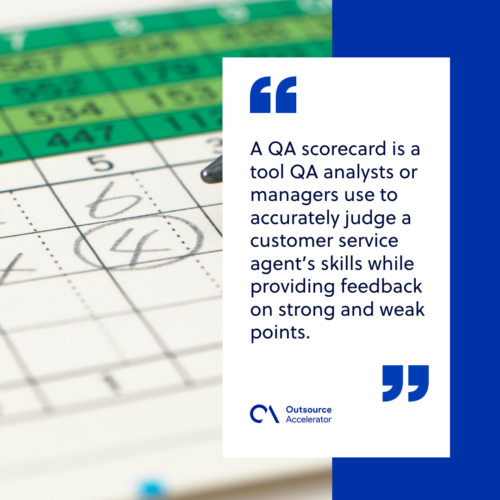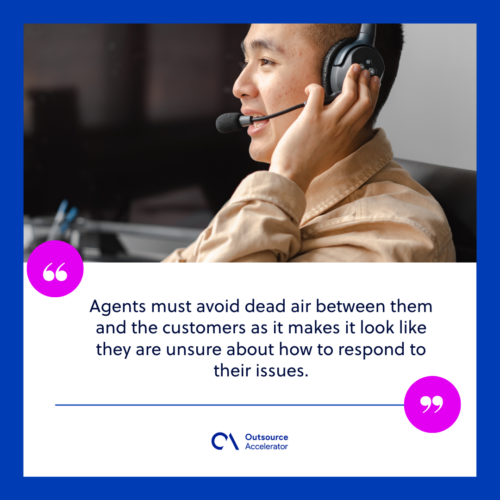How to create a QA scorecard

To successfully measure your customer experience metrics in a quantifiable manner, you can create a quality assurance (QA) scorecard.
A QA scorecard contains specific criteria to measure how well your customer service agents perform and what areas they need to improve on.
This article dives deeper into why your company needs a QA scorecard and how to create one.
What is a QA scorecard?
A quality assurance (QA) scorecard is a series of criteria that evaluate interactions with customers as objectively as possible.
It is a tool used by QA analysts or managers to accurately judge a customer service agent’s skills while providing feedback on strong and weak points.
These criteria center around company values and what the business prioritizes to measure their employees’ performance as accurately as possible.

Why you need a QA scorecard
A QA scorecard establishes the standards set by the company that the agents must adhere to in order to provide the best service possible.
It simplifies the process of collecting helpful data that managers or supervisors can use to help their employees perform better.
These criteria are then rated numerically based on a certain rubric, for example, one being the lowest and five being the highest.
Components of a QA scorecard
A QA scorecard can have different criteria, depending on the company’s requirements.
Listed below are common questions to include:
Did they greet the customer in a friendly manner?
A proper greeting opens the door for a good customer service call. It is the first thing that the customer will hear, so you want to start the call on a positive note.
Pay attention if your service representative greeted the customer in a friendly and respectful manner. Take note of things like tone, attitude, and voice modulation when speaking to the customer.
Did they establish a connection with the customer?
Establishing a rapport with the customer is very important as it increases customer satisfaction and maintains trust between the two parties.
Customers emotionally engaged with the service representative are likelier to remain loyal to the brand.
Some ways to establish a connection with a customer include:
- Introducing yourself by name
- Providing in-depth, specific answers instead of one-word, generic ones
- Call the customer by name (if they provide it)
- Let the customer know that you value their feedback
Were they responsive in addressing the customer’s concerns?
Customers don’t like to be kept waiting, so the agent must answer their concerns promptly.
Agents must avoid dead air between them and the customers as it makes it look like they are unsure about how to respond to their issues.
If an agent is unsure, the call can be transferred to a specialist or someone from a different department. An answer from someone else is better than no answer at all.

Was the issue of the customer resolved?
Did the customer end the call feeling satisfied or that their concerns have been resolved?
It defeats the purpose of customer service if a customer is unsatisfied with the call because the representative cannot help them with their problems.
As mentioned earlier, you may transfer the call to someone from another department if you cannot resolve the customer’s issue.
4 steps to build a QA scorecard
Creating a QA scorecard can be done in just a few steps as long as you have the appropriate criteria.
1. Compile your list of criteria or questions
Start creating your QA scorecard by coming up with your desired criteria for grading all aspects of customer interaction. You can structure this part according to the categories you have.
For example, you can write four sections with around three questions each. Remember to include relevant criteria that reflect the goals and values of the company.
2. Evaluate the agent from two perspectives
When creating a scorecard, it is important to evaluate the agent from the perspective of the customer and the business.
From the customer’s perspective, you will first judge if the service rep was able to address their concerns quickly and in a friendly, professional manner.
From a business perspective, you must judge if they followed company guidelines and protocols while attending the call.
3. Create scorecards for different situations
The same scorecard won’t apply to every situation, so it helps to create different scorecards for different scenarios. You can adjust the criteria and the scoring rubric accordingly, depending on what kind of call you are attending to.

4. Provide targeted feedback
Targeted feedback helps the service agent understand why they received a certain score, the more specific the feedback, the better.
Since each agent has different experiences, personalized feedback is the best way to provide insight into their strengths and how they can improve.
Improving performance using a QA scorecard
A QA scorecard is an effective and fair way to evaluate your customer service agents’ overall performance.
This useful tool makes it easier to objectively determine your service rep’s strengths and points for improvement, which they can apply to future customer interactions.
With the help of a QA scorecard, your agents can only get better at their jobs moving forward.







 Independent
Independent




